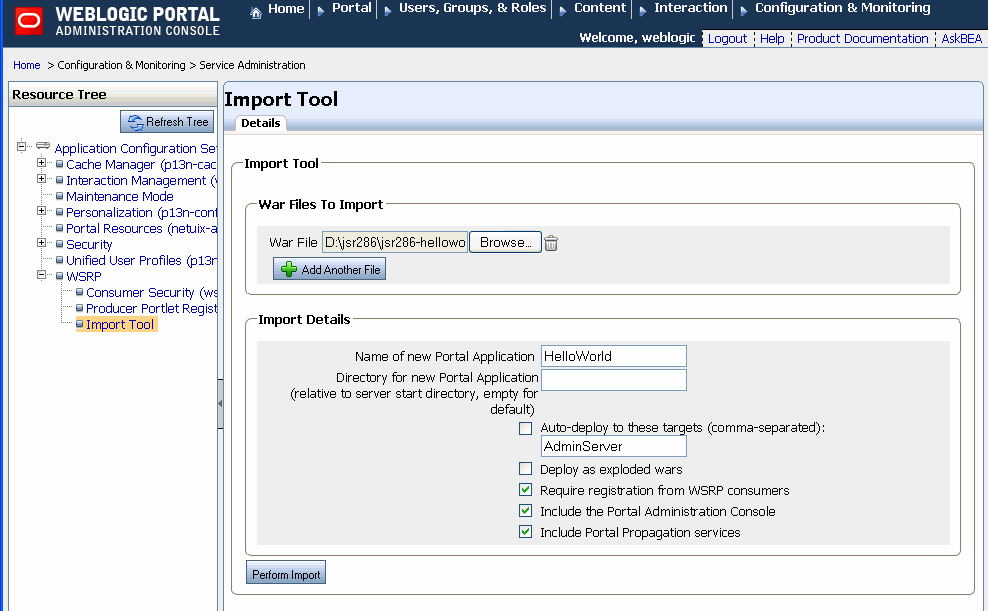Sample War File Weblogic
8 Deploying a Sample Web Application to an Oracle WebLogic Cluster. Example 8-2 illustrates a sample configuration for WAR-scoped clusters in the weblogic.xml file. Weblogic application context root is war file. War file name as context root instead of the name I have specified in weblogic.xml. How can I change the context. Guide to the WebLogic code examples The WebLogic examples. A simple example of a Web Application with instructions on how deploy it archived as a WAR file.

NOTE If you have enabled WebLogic autodeployment using -Dweblogic.ProductionModeEnabled=false, your application will automatically be deployed. However, the.jar,.war, and.ear files of the exploded directory must be contained within the applications directory. The difference between these two deployment methods in the WebLogic Builder is that in an exploded directory deployment, the name of the Web application is stated by the name of the document root directory, which in this case is HelloWorldApp. In the WAR archive deployment method, the name of the Web application is governed by the name you assign to the WAR archive file, and you can deploy the Web application to a remote Administration Server. Need For Speed Underground 1 Full Version here. The following steps will guide you through the deployment procedures for your exploded directory Web application: • Connect to the target WebLogic Administration Server by choosing Tools, Connect to Server.
In the launched dialog box, enter your specific WebLogic connection information, as shown in, and click Connect. Connect to the WebLogic Server. • To deploy your Web application, select Tools, Deploy Module. From the launched Deploy screen, as shown in, click Deploy to initiate deployment of your HelloWorldApp application to the WebLogic Server.
Deploying HelloWorldApp using the WebLogic Builder. To validate your application has been deployed, you can open the Deploy screen by choosing Tools, Deploy Module and clicking the Manage Deployments tab. Here, you can validate the status of your Web application on the WebLogic Server. If it does not appear to be deployed, highlight your HelloWorldApp application and click Deploy.
Step 7: Testing Your Web Application You can test your Web application by typing the following URL in your Web browser: where machine_name specifies your WebLogic Server's DNS name or IP address. This URL should launch your Welcome page, as shown in. The Welcome page of your HelloWorldApp application. Click the Click here link to invoke your MyServlet servlet to display the Hello World! Alternatively, you can invoke it by using the following URL: http://:7001/HelloWorldApp/Myserlet.
8.2 Configuring WAR-Scoped Coherence Clusters With this configuration, or if you want only one application to use Coherence caches, each deployed Web application becomes its own Coherence cluster. Caches will be visible to the individual modules only. For example, this could be a recommended deployment for a stand-alone WAR deployment or stand-alone EJB deployment. If you are deploying multiple WAR files, note that this configuration produces the largest number of Coherence nodes in the cluster—one for each deployed WAR file that uses coherence. Amy Winehouse Rapidshare Discografia. jar. It also results in the largest resource utilization of the three configurations—one copy of the Coherence classes are loaded for each deployed WAR. On the other hand, since each deployed Web application is its own cluster, Web applications are completely isolated from other potentially misbehaving Web applications. Note: A Web module within an EAR can have a module-scoped Coherence node but an EJB module within an EAR can only have an application-scoped Coherence node.
To Use Coherence Caches with WAR-Scoped Clusters • Use the WebLogic Server Administration Console to deploy coherence.jar and active-cache.jar as shared libraries to all of the target servers where the application will be deployed. See ' in the Oracle Fusion Middleware Oracle WebLogic Server Administration Console Help. As an alternative to the Administration Console, you can also deploy the JAR files on the command line. The following are sample deployment commands: java weblogic.Deployer -username -password -adminurl -deploy coherence.jar -name coherence -library -targets java weblogic.Deployer -username -password -adminurl -deploy active-cache. Installshield For Vb6 Decompiler. jar -name active-cache -library -targets • Import coherence.jar and active-cache.jar as optional packages in the manifest.mf file of each module that will be using Coherence. As an alternative to using the manifest file, copy coherence.jar and active-cache.jar to each WAR file's WEB-INF/lib directory. Illustrates the contents of a sample manifest.mf file.